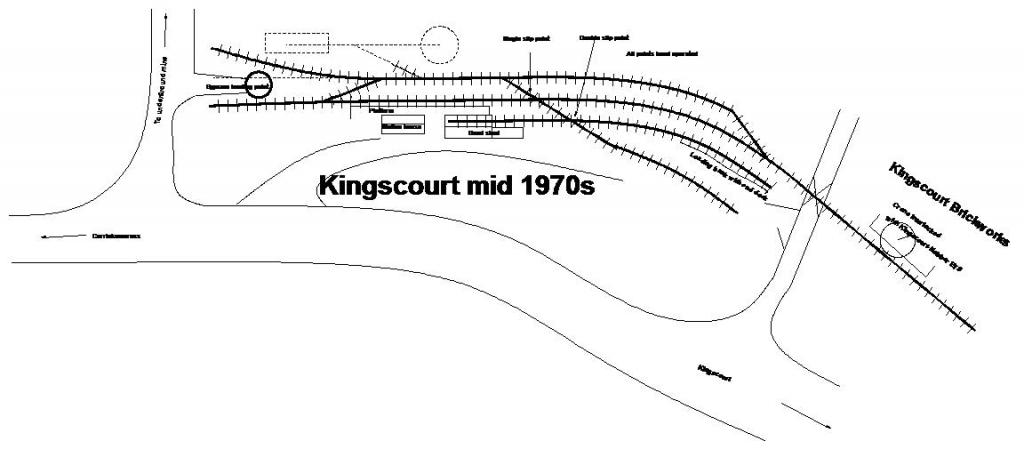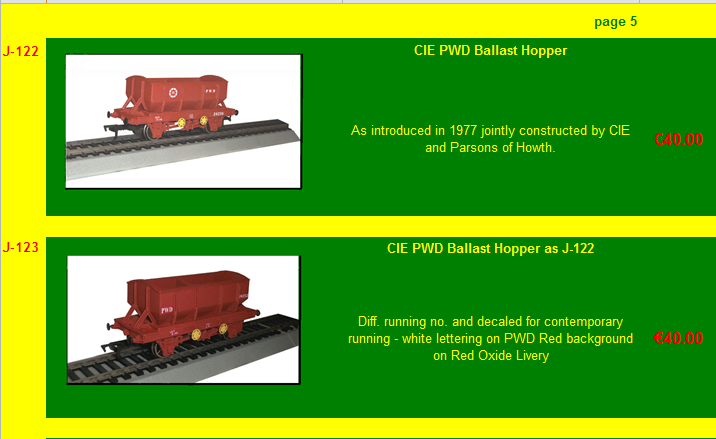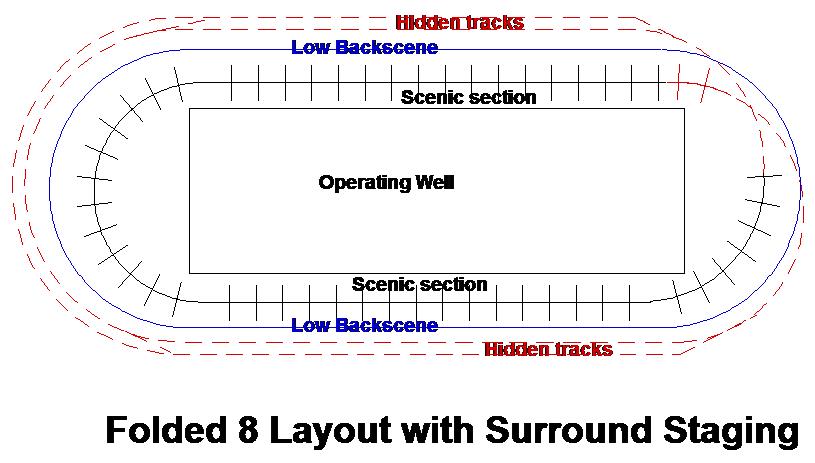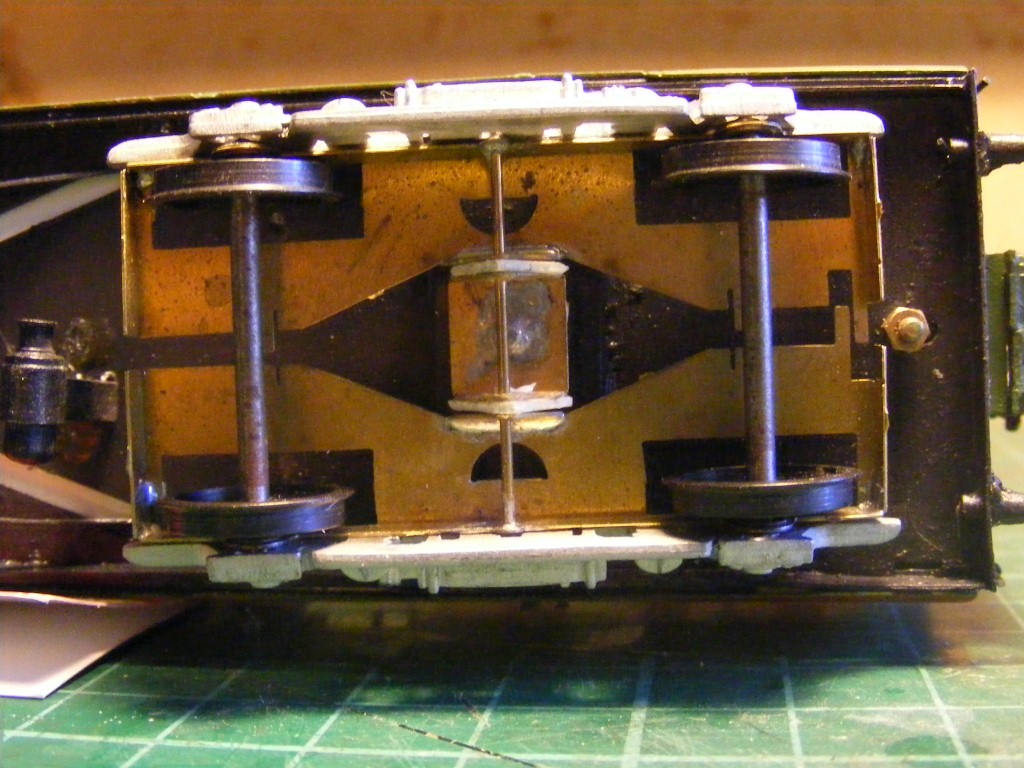-
Posts
4,728 -
Joined
-
Last visited
-
Days Won
116
Content Type
Profiles
Forums
Resource Library
Events
Gallery
Blogs
Store
Community Map
Posts posted by Mayner
-
-
The Crossley engine in the WAGR locos were supposed to have been an earlier version to that fitted to the A Class and Co Bos . Interestingly the Australians de-rated the engines which seem to have solved most of the problems and the relatively long life of the locos.
http://www.railpage.com.au/locos/x-class-diesel-wa
Apart from the Metrovicks Western Australia seem to buy locos in small batches from different manufacturers including Alco, English Electric & GM.
Not sure why they went for the 2-Do-2 wheel arrangement, possibly difficulty fitting the traction motors between the wheels on the narrow gauge, as far away as possible from dust on Outback lines or possibly track better on very light rails on branch lines.
All later classes were conventional Australian double bogie designs
-
I like the photo of Drew Donaldson's locos with an 800 Class lurking inside the shed while the MGWR 2-4-0 with flyaway cab tries to look inconspicuous between the ex-WLWR & GSWR 4-4-0s.
There is a story that museum staff thought Blanche's boiler and dome were black when the loco 1st arrived but found red paint under the soot and muck.
In most colour photos from the 50s the red cladding can be seen grinning through the muck though the domes seem to have an almost satin back finish just like the preserved loco!
-
For an idea of what the CIE A Class originally sounded like a series of videos of Western Australian Metrovicks on suburban passenger duties a late as 1986.
[video=youtube;c3L-XaV66Ds]
Perhaps maintenance was better, but the most striking thing is the lack of the smoke screen seen in photos and videos of the Irish Metrovicks.
The State Government would have been reluctant to invest in re-building or replacing the Metrovicks as lines were closed or converted to standard gauge
-
The upper section of the Ratio 500 & 503 may be based on a standard Railway Signal Company rather than a GWR design and is close in general appearance to cabins used by the GSWR, MGWR & WLWR. Gort, Killucan, Mallow South and Roscrea come to mind.
http://www.ehattons.com/40599/Ratio_500_GWR_Signal_Box/StockDetail.aspx
It might even be possible to combine several kits to model larger cabins such as Athlone West or Galway http://www.signalbox.org/overseas/ireland/athlonewestjcn.htm
The Irish boxes tended to have brick bases with relatively small windows in the locking room. Lamp oil would usually be stored in a separate lamp room http://www.ehattons.com/40386/Wills_Kits_SS22_Lamp_huts_with_2_oil_drums/StockDetail.aspx. The railway company did not want a stray fag end or ember from the fire causing an explosion in the locking room.
-
 1
1
-
-
Well done the rivet detail and plasticard overlays really capture the angular look of these locomotives.
-
The detailing always seems to be the slowest part of any modelling project. Great step by step on what's involved in scratch building a loco.
-
You might of hit the jackpot Minister the horizontal tie-bar through the framing seems to be a common feature on CBSCR covered goods wagons.
I have seen grounded bodies of GSWR, GNR & GSR vans with aluminium sheeting sandwiched between the framing and planking. This may have been an economy measure to use a lower grade of timber for body planking.
-
 1
1
-
-
Rich
You have really captured the atmosphere of the station buildings. I spent a very enjoyable day about 20 years ago taking photos of the buildings at Kingscourt and Athboy.
Kingscourt could make a very attractive model as a terminus or as a through station, there were even plans at one stage to extend the line to Carrickmacross and Armagh.
I have drawn a sketch of the track layout before it was rationalised in the 80s. Gypsum was unloaded directly from tipper trucks into railway wagons from a raised concrete ramp and turntable arrangement, wagons seem to have been positioned by a winch arrangement rather than loco.
The gypsum loading ramp and turntable seems to have been on the site of the cattle bank or possibly cattle shed road, which was slewed over and the loco shed demolished There are some nice photos of this end of the station in GSR days complete with ex MGWR Standard Goods & 6 wheel coaches in Donal Murrays "Great Southern Railways" pictorial Iain Allen 2006
The slip points on the crossover to the goods yard is almost a MGWR trademark Edenderry & Athboy had a similar arrangement, the slips may have been replaced by turnouts in CIE days.
Although the loco shed was demolished the turnout from the loop to the loco yard is probably still in place. The loading of wagons on the running line at the brickworks loading bank was the biggest oddity at Kingscourt. Brick traffic was important into CIE days and the crane on the loading bank was locked by the Kingscourt-Nobber later Wilkinstown section staff.
Passenger trains ran to and from Broadstone and later Amiens St with a 650 Class or a Midland Standard Goods and a few 6 wheelers. Services were fairly sparse usually morning and evening and the occasional mid day train.
The Kingscourt goods was scheduled for steam operation into the late 1950s with large Midland (j5) or GSWR (J4 or possibly J9) working the 3 trice weekly goods.
Traffic from Kingscourt was diverted to run over the GNR line and Clonsilla-Junction Navan closed to regular traffic apart from cattle specials from LIffey Junction to Drumree & Kilmessan before complete closure in 1963
-
Fair play to Pat, Stephen, Fran and Richie for their initiative and being prepared to take the risk with commissioning a rtr wagon. The ballast hopper is an excellent choice and hopefully generate the critical mass in terms of sales to finance the development of the cement bubble.
A bit modern for my taste but very difficult to resist.
-
[/size]
Has anyone else come across these? I found a reference to them recently and they certainly look the business. Sorry but I haven't got a link to them.Stephen
The Redplant100 Hopper Wagons seem to be the same the Model Irish Scale Rail (MISR) p.w. hoppers produced by James McKay
Photos © James McKay MISR
The MISR CIE H van and Bullied corrugated open had a very good review in May 2013 New Irish Lines. There seems to have been plans to introduce a wide range of wagons including hoppers, tankers before MISR disappeared off the radar.
It may be worth while contacting James McKay 2 Coneyburrow, Dublin Road, Edenderry or misr@eircom.net to check if he is still producing wagons.
-
Still amazed by that photo of the turf train. What a superb piece of adaptability & as already commented, a model of such would perforce need an explanatory label.
My aging, but much treasured copy of S Maxwell Hajducki's Railway Atlas of Ireland shows two Bord na Mona systems in north Mayo - Oweninny [1958] & Bangor Erris [1964]. Had the line to Belmullet been built, then perhaps this resource might have been tapped earlier & provided a reason to keep the line open into the 1950s. Sadly, can find no turf railways anywhere near Arigna & with a half decent coal supply the locals would perhaps not need the turf anyway?
In 7mm scale, Alphagraphix do a range of etched brass 6 wheel coaches, plus there are their cardboard kits [with chassis available too]. This has certainly become a possible project for me, as the stock wouldn't be too difficult to construct, though a proper weathering job might take some effort and as to a turf load, I wonder what could be used in this scale? Certain types of rabbit food perhaps? Am sure the fertile mind out there will soon come up with suggestions!
The BNM systems in North Mayo were built to serve Bellacorrick power station on the Oweninny system rather than local needs. Bangor Erris is a feeder system with road transfer to Bellacorick. A broad gauge line might have survived long enough to bring in the construction material for the power station and link to the National Grid. It would have made sense to convert Bangor Erris -Bellacorrick to narrow gauge and abandon the broad gauge line.
Most people in areas where peat is plentiful including most of the Central Plain and Mountainous areas had access to and harvested their own peat. Attempts to control an individuals right to cut turf for their own personal use in the name of conservation while Bord na Mona stip mines the commercial bogs is a major issue in many areas
-
I suppose it depends on whether you prefer the post or pre 1970s block train era with individual wagon loads distributed by rail loose coupled goods trains often to most villages and towns or the block train era.
The Texaco siding at the tank farms in Tivoli seems to have been busy with oil traffic in the 70s with heavy fuel oil for Ballinacourty and Burmah oil traffic (petrol & diesel) for Limerick, and presumably Texaco traffic.
The siding was the terminal for the oil and magnesite trains and had a connection into the Quigley Magnesite Roofchrome factory, which eventually became the siding to the Tivoli container terminal.
-
Up to the block train era fertiliser and possibly agricultural lime would have been sent in individual wagon loads in sheeted opens. There was probably more competition in the market before NET Shelton Abbey came on line in the 60s. Beside Gouldings North Wall, NET and Albatros, there were also rail linked feriliser factories at Foynes and Wicklow quay operating in the 1960s.
Oil and petrol would have also been transported in individual wagon loads into the 70s with stations in medium sized towns having oil depot since the 1930s. The Irish Shell and ESSO tank wagons seem to have been mainly the older Pre-WW2 cradle mounted tanks though Caltex had a fleet of more modern anchor mounted tanks similar to the new Bachmann wagon http://www.bachmann.co.uk/image_box.php?image=images1/branchline/38-776.jpg&cat_no=38-776&info=0&width=650&height=461
I am not sure about Cork, Foynes and Dublin Ports seem to have been the main originating points before the opening of the Whitegate Refinery.
Foynes nearly closed in the early 60s with the loss of oil and fertiliser traffic before the revival with the starting of heavy fuel oil traffic to the Cement factories and Silvermines ore traffic.
One scenario could be a rail or pipeline from Whitegate to the Youghal/Waterford line and supply most of the countrys petrol and diesel by rail rather than road or coastal shipping.
The transportation of tar by rail tanker seems to have been pretty much a 50-60s thing before that tar and bitumen seems to have been mainly delivered in open wagons in 45gal drums, another interesting load for an open wagon
-
 1
1
-
-
Carriage Sheds with corrugated iron roofs seem to have been common enough up to the 1930s when the GSR removed them to reduce the rates bill.
The Ratio kit might be a good starting point http://www.rmweb.co.uk/community/index.php?/blog/574/entry-8333-a-carriage-shed-at-last/.
The GSWR & GNR tended to build terminus stations with overall roofs that could be used as carriage sheds, the MGWR and smaller corrugated companies tended to provide separate carriage sheds. There were a few exceptions at one stage Cahirciveen on the GSWR which was operated more as a terminus than a through station had a corrugated iron carriage shed and no overall roof, both Tramore & Waterford Manor on the W&T had overall roofs.
-
One idea if you have a continuous run or oval is to use what American modellers "Surround Staging and hide he storage track behind a low backscene. The hidden track could be single or double track either a simple loop off the running line on a simple oval or part of a folded 8 arrangement.
This sort of arrangement can work well behind the scenic part of a layout in an attic as you only need enough room for a double or single line of track. I had this sort of arrangement on an N gauge layout in Dublin, I kept the scenic boards to a maximum of 300mm with removable buildings in order to reach point motors on the hidden section. Track cleaning was taken care of by a "CMR Clean Machine" running round the main line and hidden storage once a month.
-
Excellent stuff, I am thinking strongly of getting a GW Models press.
What's your preferred method for cutting out the footplate and side tanks?
-
The wheel puller is available along with a range of really useful tools from G W Models who advertise in Model Railway Journal.
The back to back gauge (big metal thingy) was supplied by Terry McDermott of TMD the Genesis of the current range of SSM kits.
The conversion of the loco took approximately 1 hour.
Dapol/Airfix tank wagon conversion
The solebars (side frames) are packed out with 1mm plasticard otherwise the 21mm wheelsets would not fit. Wheels are Ultrascale on 28mm pin point axles.
Commonwealth Coach bogie with MJT torsion bar suspension unit with 1mm plastciard packers
Economy 21mm coach bogie conversion

Old Hornby Stanier bogie with plasticard bolster and standard OO wheelset, std 26mm axle cut in two and pushed out to 28mm 2mm brass sleeve.
The "economy" conversion was remarkably effective and trouble free in operation at exhibitions, along with a pair of old style Hornby Staniers I also had a MK3 Push Pull set converted from Lima MK3s with plasticard bolsters
-
you could use any standard you like and modify it for 21mm, for example use DOGA - intermediate flange ways etc this would allow to use the existing 00 gauge wheel profiles but on a longer axle
I re-gauged one of my MM B141s using the existing Bachmann wheels on 26mm 2mm dia axles and re-gauged the other pair using Ultrascale wheel sets.
The thread of the Bachmann wheels are wider than the "OO Finescale"/EM profile wheels produced by Ultrascale & Alan Gibson.
I found that the re-gauged Bachmann wheels fouled the inside of the B141/181 side frames and it was necessary to remove a lot of plastic from inside the frames before the loco would run.
This does not seem to be a problem with the MM 071 as the bogie side frames are thinner.
Loco re-gauged with existing wheels top Ultrascale wheels bottom
I used small 2mm top hat brushes secured to the axle with Loctite 601 to restrict side play
-
 1
1
-
-
Another repaint No14 posed on newly re-laid main track
Based on Rio Grande Southern 4-6-0 No 20 converted from a Bachmann 4-6-0 No 14 has been the backbone of the fleet since the Connie 2-8-0 threw a wobbler with a faulty motor in 2011. No 14 has used up my stock of GSR (Floquil) weathered black paint
 though I have two unopened bottles of Scalecoat acrylic for my next repaint.
though I have two unopened bottles of Scalecoat acrylic for my next repaint.C21 arrives in the siding with a freight as No 14 holds the main
All is not what it seems in this photo the light is closing in and the C21 is on a rescue mission.
I had just finished track cleaning and sent out No14 and another track powered loco No 11 to clear the yard and haul back their trains to the garden shed, when the DCC system shut down with a dead short. I could not find the fault later I found a small coin had fallen onto one of the circuit breakers that protects the DCC command station and shut down the entire system:

A bit like the saga of Tralee & Dingle 8 in the spring of 1952 when they could not get 1T to steam. The C21 had to make an extra two trips to haul all the stock home to the shed, No 11 & 14 got to fly.
-
Love the U2 on the goods the U2s straight out of Mac Arnold's NCC saga with 4-4-0s working goods trains on the Cookstown & Derry Central lines and ex NCC branches.
-
The main drawback with both the Dapol and Heljan models is that the majority of the ESSO Teo. tank wagons had the noticeably longer Class A Tank barrel. Its easy enough to extend the barrel of the Dapol tank with parts cut from another kit, but expensive to chop up a rtr model.
http://paulbartlett.zenfolio.com/essoatankwagonvb/h32cd852b#h32cd852b
http://paulbartlett.zenfolio.com/db999xxxtank/hb25d798#hb25d798
-
I converted a couple of MM B141 to 21mm gauge, I have not had time to build a layout
The diesel locos can be converted easily enough, the coaches are more of a challenge as the bogies are unsuitable for the wider gauge.
Converting the locos is basically a matter of swapping out the wheel sets with those on a longer axle. Its possible to re-use the existing Bachmann/MM wheelsets some users have turned down the wheelsets to S4 standards.
Murphy Models coaches need new bogies and most rtr wagons new chassis as the width between the bogie sidframes/axleboxes is too narrow for a 21mm wheelset.
Tony Miles "Adavoyle" now in the care of the South Dublln Model Railway Club (SDMRC) is probably the most famous 21mm S4 layout, A number of SDMRC members built an S4 model of Belturbet in 21 mm gauge. The Model Railway Society of Loughrea is built in 21mm to EM/OO gauge track standards. Andy Cundick a 21mm S4 layout based on Valencia Harbour regularly appears on the UK exhibition circuit
-
 1
1
-
-
I always had a soft spot for the "Large Tanks" a tin plate model based on a photo of Lough Gill was my first "scratch built" loco that actually ran. The body was glued together from soft drinks tins, the chassis was from a second hand Triang-Hornby Princess bought for £1 re-wheeled with Jinty wheels it waddled but at 16 or 17 was my pride and joy and only working loco.
-
Hi Helene
A young lad living in the area around Heuston would have a much better chance of breaking out of the slums and poverty than a lad living in the area around Connolly. The area around Connolly (Amiens St) had quite a history. The area around Railway Street between Gardiner and Amiens Street was Monto the old red light area shut down after the founding of the Free State, Sherriff always seems to have been some thing of a no-go area, excellent baggage for a obsessive father who is unable to shake off his roots.
Going to the trains building a large model railway could be a lifetimes work the father like Pete Waterman the musical producer might commission professional model builders to re-create his childhood memories.
During the 1970s Harry Connaughton a prolific professional modeller produced high quality models of mainly Irish steam era locos and rolling stock mainly for private clients. Dave a member of this news group builds layouts to order allowing dad more time to cut himself off from the family and play God.
.png.c363cdf5c3fb7955cd92a55eb6dbbae0.png)








.jpg.16907ae490a59f62b3f6ae425e29cc6d.jpg)
.jpg.877f5173e130254dbc2d141eef05d960.jpg)
The Official Irish 'Might Have Beens' Thread
in General Chat
Posted
The Belfast Central scheme was mentioned in E M Patterson's "Ballymena Lines" The BCR obtained an Act to build a 3' gauge line to Ardoyne, a separate company the Ballyclare, Ligoneil and Belfast Junction obtained an Act to extend the line from Ardoyne to Doagh possibly linking up with the Ballymena & Larne narrow gauge.
Not to be outdone the Londonderry and Larne Railway had plans for a line from Ballymena through Portglenone across the Sperrin Mountains through Dungiven and Claudy to Derry City. This could have opened up the prospect of Fish Trains from Burtonport to Larne